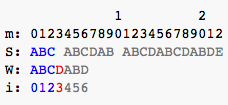Knuth–Morris–Pratt algorithm
- Notes from KMT wiki
KMP algorithm searches for occurrences of a "word" W within a main "text string" S by employing the observation that when a mismatch occurs, the word itself embodies sufficient information to determine where the next match could begin, thus bypassing re-examination of previously matched characters.
Supposed
Wwith size $$n$$ andSwith size $$k$$.We can build up a table
Twith $$O(k)$$ for $$O(1)$$ look up in the KMP algorithm, the table record the "sufficient information" embodied in the word itself.Assuming the prior existence of the table
T, the search portion of the KMT algorithm has complexity $$O(n)$$.
Table T Intuition
W = "ABCDABD" and S = "ABC ABCDAB ABCDABCDABDE"
m, denoting the position within S where the prospective match for W begins,
i, denoting the index of the currently considered character in W.
In each step the algorithm compares S[m+i] with W[i] and advances i if they are equal.
 after this pic:
after this pic: m = 3, i = 0
 after this pic:
after this pic: m = 4, i = 0
 after this pic:
after this pic: m = 10 - 2, i = 2
 after this pic:
after this pic: m = 10, i = 0
 after this pic:
after this pic: m = 11, i = 0
 after this pic:
after this pic: m = 17 - 2, i = 2
 after this pic: find a match!
after this pic: find a match!
The entries of
Tare constructed so that **if we have a match starting atS[m]that fails when comparingS[m + i]toW[i], then the next possible match will start at indexm + i - T[i]inS.T[i]is the amount of "backtracking" we need to do after a mismatch.T[0] = -1, which indicates that ifW[0]is a mismatch, we cannot backtrack and must simply check the next character- Although the next possible match will begin at index
m + i - T[i], we need not actually check any of theT[i]characters after that, so that we continue searching fromW[T[i]]
